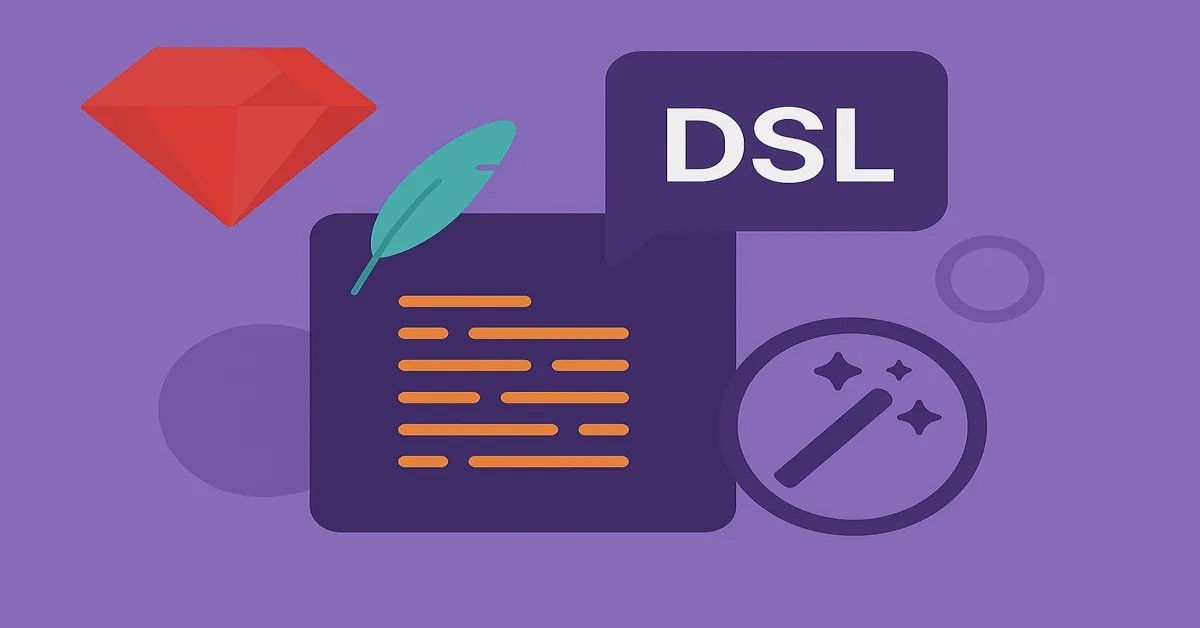How Ruby’s metaprogramming powers a new kind of code expressiveness—and what it really takes to build DSLs that matter.
In the often brittle and bombastic world of software development, few tools inspire both awe and apprehension quite like metaprogramming. Its promise is profound—code that writes code, systems that evolve themselves, and frameworks that feel like natural language. But its misuse, misunderstood power, and subtle complexity have long earned it a reputation as a double-edged sword.
And yet, in Ruby, metaprogramming is not an exotic trick—it’s the language’s heartbeat. It’s how Rails was built. It’s why RSpec, Capybara, and Chef feel so readable. It’s why Ruby developers often speak of “elegance” with more frequency than most programming circles.
At the center of that elegance lies a practical application: Domain-Specific Languages (DSLs)—mini-languages within Ruby that allow developers to express logic in a domain’s own terms. And whether you’re building infrastructure scripts, test suites, UI declarations, or configuration files, DSLs are Ruby’s not-so-secret weapon.
This article explores how to use Ruby’s metaprogramming tools to build professional-grade DSLs, breaking down concepts, pitfalls, and techniques that every Rubyist—from novice to veteran—should understand.
What Is Metaprogramming, Really?
Metaprogramming is the practice of writing code that generates or modifies other code at runtime. Ruby makes this natural because:
- Classes are open and mutable
- Methods can be defined dynamically
- Code blocks are first-class citizens
- Reflection is trivial
In essence, metaprogramming allows you to bend Ruby to fit your problem domain—instead of forcing the domain into your programming mold.
What Is a Domain-Specific Language (DSL)?
A DSL is a language tailored for a specific problem domain. Unlike general-purpose programming languages, a DSL provides a syntax and structure closer to human language or business logic.
Examples:
- RSpec for testing rubyCopyEdit
describe User do it "returns full name" do expect(user.full_name).to eq("John Smith") end end - Rails migrations for schema changes rubyCopyEdit
create_table :users do |t| t.string :email t.timestamps end
They don’t look like standard Ruby—but they are. And that illusion is created using metaprogramming.
The Building Blocks of DSLs in Ruby
To create DSLs, you must understand the metaprogramming tools that Ruby provides. Let’s go over the core techniques.
1. method_missing
Used to intercept calls to undefined methods.
rubyCopyEditclass CommandProxy
def method_missing(name, *args, &block)
puts "Intercepted: #{name}(#{args.join(', ')})"
end
end
cmd = CommandProxy.new
cmd.launch_rocket("Mars") # => Intercepted: launch_rocket(Mars)
This is great for building fluid APIs, but be careful—overuse leads to brittle code and poor performance.
2. define_method
Dynamically defines methods at runtime.
rubyCopyEditclass Person
[:name, :email].each do |attr|
define_method(attr) do
instance_variable_get("@#{attr}")
end
define_method("#{attr}=") do |value|
instance_variable_set("@#{attr}", value)
end
end
end
Cleaner than method_missing, and safer. Ideal for boilerplate reduction in DSLs.
3. Blocks and instance_eval
Allows DSLs to use block syntax in a specific context.
rubyCopyEditclass Config
attr_accessor :settings
def initialize
@settings = {}
end
def set(key, value)
@settings[key] = value
end
end
def configure(&block)
cfg = Config.new
cfg.instance_eval(&block)
cfg
end
cfg = configure do
set :host, "localhost"
set :port, 3000
end
This is the cornerstone of most Ruby DSLs—executing a block in a custom scope.
4. Open Classes and Monkey Patching
All classes in Ruby are open. You can redefine or extend them anytime.
rubyCopyEditclass String
def shout
self.upcase + "!"
end
end
puts "hello".shout # => HELLO!
Useful for DSLs when extending core classes, but controversial—avoid unless necessary.
Designing a DSL: From Use Case to Code
Let’s walk through building a DSL from scratch—a configuration DSL for defining a pipeline of tasks.
Goal:
rubyCopyEditpipeline do
step "load data" do
puts "Loading..."
end
step "transform" do
puts "Transforming..."
end
step "export" do
puts "Exporting..."
end
end
Step 1: Define the DSL Host
We need a class that will store and manage our steps.
rubyCopyEditclass Pipeline
def initialize
@steps = []
end
def step(name, &block)
@steps << { name: name, action: block }
end
def run
@steps.each do |s|
puts "Running: #{s[:name]}"
s[:action].call
end
end
end
Step 2: Create the DSL Entrypoint
rubyCopyEditdef pipeline(&block)
pipe = Pipeline.new
pipe.instance_eval(&block)
pipe.run
end
Now when you call pipeline, it executes in the context of a Pipeline object.
Step 3: Run It
rubyCopyEditpipeline do
step "load data" do
puts "Loading..."
end
step "transform" do
puts "Transforming..."
end
step "export" do
puts "Exporting..."
end
end
Output:
makefileCopyEditRunning: load data
Loading...
Running: transform
Transforming...
Running: export
Exporting...
Your first working DSL—elegant, readable, and domain-focused.
Best Practices for Metaprogramming and DSLs
✅ Start with the Domain
Begin by writing the syntax you wish existed, then make Ruby accommodate it. The goal is readability and expressiveness, not technical wizardry.
✅ Use Explicit Contexts
Prefer instance_eval or yield self over global method definitions. This keeps DSLs scoped and prevents name collisions.
✅ Limit Magic
Avoid overusing method_missing. It can obscure behavior and make debugging difficult. Prefer define_method or explicit methods.
✅ Keep It Predictable
A DSL should not surprise the developer. If it hides too much or behaves inconsistently, it becomes frustrating rather than elegant.
✅ Document Well
Because DSLs don’t look like typical Ruby, good documentation is essential. Explain the structure, options, and purpose clearly.
Real-World DSLs Built with Ruby
1. RSpec (Testing)
RSpec’s syntax is one of the best-known Ruby DSLs:
rubyCopyEditdescribe Order do
it "calculates total" do
expect(order.total).to eq(100)
end
end
Internally, it uses method_missing, define_method, and instance_eval to create a fluent interface.
2. Rails Migrations (Database)
Rails migrations use blocks and open classes:
rubyCopyEditcreate_table :users do |t|
t.string :email
t.timestamps
end
create_table is a method defined on ActiveRecord::Migration, and t is an instance of a helper class.
3. Chef / Puppet (Infrastructure)
Chef uses Ruby DSLs to define infrastructure as code:
rubyCopyEditpackage "nginx"
service "nginx" do
action [:enable, :start]
end
Readable, declarative—and pure Ruby under the hood.
DSL vs Configuration: When Not to Use a DSL
Not all problems need a DSL. Sometimes a config file (YAML, JSON, TOML) is better:
- DSLs require Ruby execution = security risk
- DSLs introduce complexity
- DSLs are harder to parse or validate
Use a DSL when you want logic and configuration together, and the domain benefits from expressive syntax.
The Future of DSLs in Ruby
As Ruby continues to evolve (with static typing tools like Sorbet or Steep, and performance improvements from YJIT), DSLs remain one of its most enduring superpowers.
New areas like:
- AI pipelines
- Static site generation
- Developer tooling
…are emerging as fertile ground for Ruby-based DSLs—where developer expressiveness and clarity matter more than raw speed.
Conclusion
In Ruby, metaprogramming is not a luxury—it’s a design principle. Used wisely, it enables the creation of Domain-Specific Languages that don’t just reduce code—they reshape how we think about code.
DSLs are not about magic syntax or clever tricks. They’re about clarity, focus, and making the code speak the domain’s language. In an age of complexity, that’s a superpower worth mastering.
So write that DSL. Define your own describe, your own pipeline, your own elegant little language. Ruby is waiting.
Read:
Kotlin Wasm (WebAssembly): Writing Web Apps in Kotlin Without JS
Kotlin and AI: Building an AI Chatbot Using Kotlin + OpenAI API
Lean Architecture in Kotlin: From Theory to Code
Kotlin Native: Building a CLI Tool Without JVM
FAQs
1. What is metaprogramming in Ruby, and why is it powerful?
Metaprogramming in Ruby is the ability to write code that modifies or defines other code at runtime. It’s powerful because Ruby’s dynamic nature allows developers to create flexible, expressive APIs—enabling features like dynamic method creation, custom DSLs, and runtime behavior changes with minimal boilerplate.
2. What is a Domain-Specific Language (DSL) in Ruby?
A DSL is a custom mini-language built within Ruby, designed to model a specific domain clearly and concisely. Examples include RSpec for testing and Rails migrations for database schemas. DSLs improve readability by letting developers express ideas in terms that closely mirror business or application logic.
3. Which Ruby features are most useful for building DSLs?
Key features include:
method_missingfor handling undefined method callsdefine_methodfor dynamic method creationinstance_evalandclass_evalfor scoped execution- Blocks and procs for context-aware configuration
- Open classes for extending or enhancing base objects
These allow you to mold Ruby’s syntax into a language-like interface tailored to your domain.
4. What are the risks or downsides of using metaprogramming?
While powerful, metaprogramming can:
- Reduce code clarity if overused
- Obscure bugs due to dynamic behavior
- Complicate debugging and stack traces
- Break future compatibility if not carefully designed
Best practice is to use metaprogramming conservatively and document DSLs well to ensure maintainability.
5. When should I use a DSL instead of a configuration file (like YAML or JSON)?
Use a DSL when:
- You need logic or conditional behavior in configuration
- The domain benefits from a more expressive, readable interface
- You want to embed valid Ruby code in setup or testing scenarios
If the setup is static, unchanging, or purely declarative, a config file might be simpler and safer.











